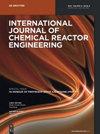Simulation investigation of the effect of heating temperature and porosity of porous media on the water evaporation process
IF 1.6
4区 工程技术
Q3 Chemical Engineering
International Journal of Chemical Reactor Engineering
Pub Date : 2023-08-30
DOI:10.1515/ijcre-2023-0090
引用次数: 0
Abstract
Abstract In the study, carbon fiber as porous media, water and vapor as liquid and gas phases, respectively, the evaporation process of multiphase fluid in carbon fiber was explored based on the pore network model. The Micro-CT technology was adopted to reconstruct the structure of carbon fiber. The applicability of the CFD model adopted in the simulation was validated by experiment. Effect of heating temperature and porosity on the evaporation process was investigated in detail. The study found that at various heating temperatures, fluid temperature increases gradually with time, and tends to be constant when it reaches a certain temperature. When heating temperature is high, the constant temperature is large, the time to arrive the constant temperature is short. The liquid evaporation rate V e and the heat absorbed by the fluid every 0.5 s Q0.5 increase first, and decrease gradually when a maximum value is reached. When the heating temperature is high, the maximum that V e and Q0.5 can be obtained is also large, the required time is also short. In porous media with different porosity, fluid temperature rises to an approximate constant. V e and Q0.5 increase first, and decrease gradually after reaching a certain maximum value. The maximum values of V e and Q0.5 in porous media with porosity of 0.598 are the largest.加热温度和多孔介质孔隙率对水蒸发过程影响的模拟研究
摘要本研究以碳纤维为多孔介质,水和蒸汽分别为液相和气相,基于孔隙网络模型探讨了多相流体在碳纤维中的蒸发过程。采用Micro-CT技术对碳纤维进行结构重建。实验验证了CFD模型在模拟中的适用性。详细研究了加热温度和孔隙率对蒸发过程的影响。研究发现,在不同的加热温度下,流体温度随时间逐渐升高,达到一定温度时趋于恒定。当加热温度高时,恒温较大,达到恒温的时间较短。液体蒸发速率Ve和流体每0.5吸收的热量 s Q0.5先增大,当达到最大值时逐渐减小。当加热温度高时,可以获得的Ve和Q0.5的最大值也大,所需时间也短。在具有不同孔隙率的多孔介质中,流体温度上升到近似常数。Ve和Q0.5先增大,达到一定的最大值后逐渐减小。孔隙率为0.598的多孔介质中的VE和Q0.5的最大值最大。
本文章由计算机程序翻译,如有差异,请以英文原文为准。
求助全文
约1分钟内获得全文
求助全文
来源期刊
CiteScore
2.80
自引率
12.50%
发文量
107
审稿时长
3 months
期刊介绍:
The International Journal of Chemical Reactor Engineering covers the broad fields of theoretical and applied reactor engineering. The IJCRE covers topics drawn from the substantial areas of overlap between catalysis, reaction and reactor engineering. The journal is presently edited by Hugo de Lasa and Charles Xu, counting with an impressive list of Editorial Board leading specialists in chemical reactor engineering. Authors include notable international professors and R&D industry leaders.

 求助内容:
求助内容: 应助结果提醒方式:
应助结果提醒方式:


